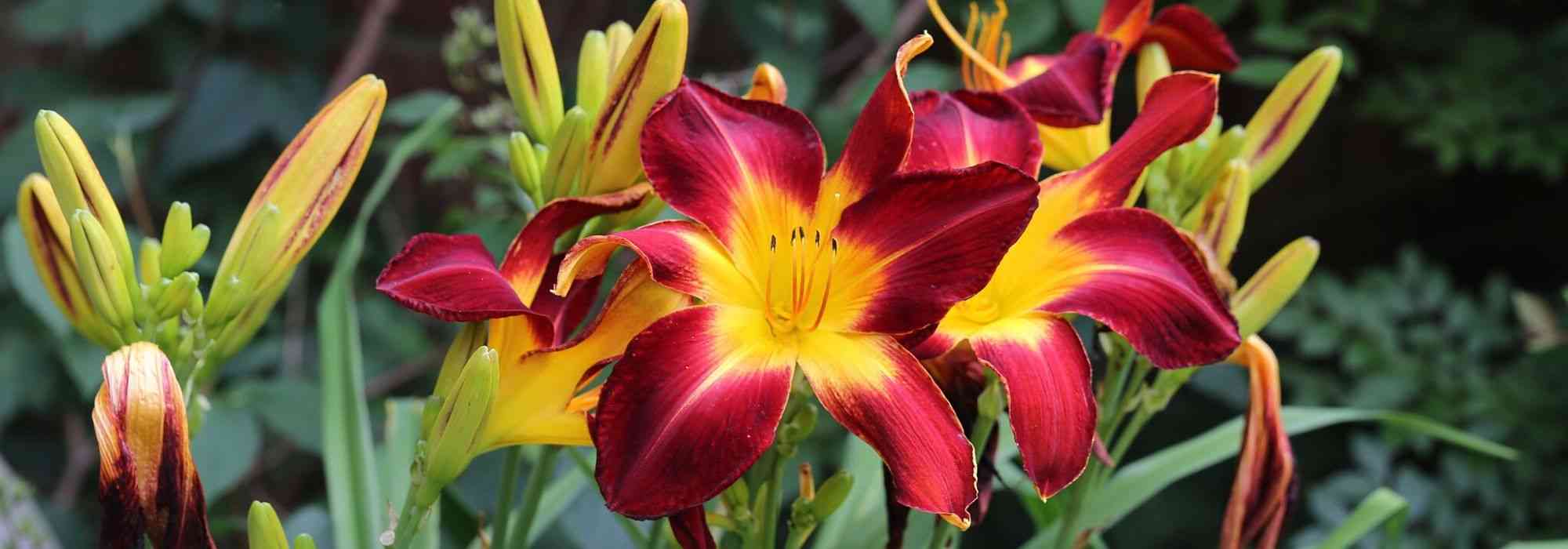
Daylilies: 7 ideas for successful combinations
Combining to suit every taste
Contents
Daylilies, also called daylily, are highly prized for their large colourful summer flowers and ease of cultivation.
Planted in full sun or partial shade, they are perfect in flowerbeds, rockeries or as edging. They declinate into a wide palette of colours, most often in vivid but also pastel shades.
This great diversity allows us to create different moods, from naturalistic garden to romantic setting to exotic tableau. Discover our 7 ideas for beautiful pairings with Daylilies!
100% daylilies
The diversity of daylilies is so great that it is easy to create a cheerful, dynamic flower bed made entirely of daylilies. For this, do not hesitate to play with heights, colours, flower shapes (double, single, trumpet-shaped, star-shaped, with undulate petals, etc), and to combine different varieties to extend flowering over several months. Indeed, flowering of daylilies does not last very long (around one month) but some varieties have the good idea of being perpetual and by combining early and late varieties, you will enjoy them for longer.
Finally, remember also that each flower lasts only one day and regularly remove faded flowers to encourage the plant to produce new flowers.
Here are some ideas to create a flower bed made solely of daylilies:
In the foreground
Place smallest daylilies at front of your bed or along edge. Dwarf daylilies do not exceed 35–40 cm in height and, icing on the cake, they are perpetual! I recommend following varieties:
- Stella de Oro is a wonderful miniature variety, robust and bright, with golden-yellow flowers from May to October;
- Mini Stella offers vivid yellow flowering from June to September;
- Gipsy Turtle is an old, timeless variety, velvety crimson-red with a golden heart, from June to August;
- Rosy Returns has a delightful old-rose colour edged with a deeper pink halo and a vivid yellow throat from June to September;
- Thumbelina is a particularly floriferous variety, a lovely bright orange in June/July.
In middle of bed
In middle of bed, choose medium-sized daylilies between 45 and 70 cm in height. You may have daylilies of the same size placed one behind the other. That is not a problem. Simply choose varieties with staggered flowering times. Most daylilies flower in June/July but there are early varieties that flower as early as May and late varieties that flower towards end of summer.
For the earliest varieties, I suggest:
- the very pale salmon-pink flowering around a lime-green throat of Lullaby Baby (45 cm)
- the large, full fuchsia-pink flowers with yellow heart of Olive Bailey Langdon (70 cm)
- the yellow-orange trumpets of botanical species H. middendorffii (60 cm)
For mid-season flowering, opt for varieties:
- El Desperado with unusual colours, yellow maculate and marginate with purple, flowering in August and September (70 cm)
- Alaqua with superb frilled beige-pink petals and a purple heart and edging in July and again in September (50 cm)
For later summer flowering, choose:
- Crimson Pirate, a very elegant variety with fine, narrow petals in bright red (70 cm)
- Final Touch with large flowers shaded in pinks (80 cm)
At back of bed
For back of bed, tallest daylilies are ideal — try, for example:
- Pink Damask offers beautiful coral-pink corolla (95 cm)
- Shooting Star with pale lemon-yellow flowering (90 cm)
- George Cunningham with star-shaped salmon flowers (90 cm)
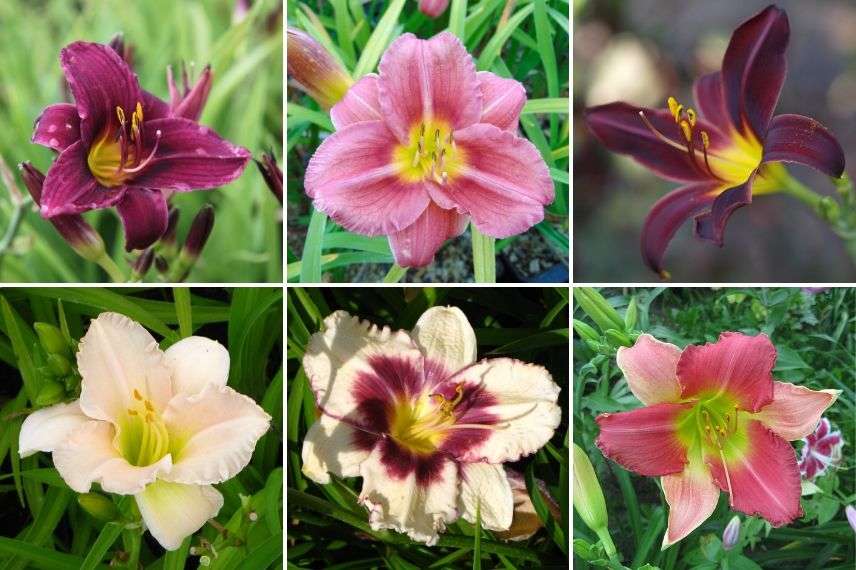
An example of a 100% daylilies combination for a gradient of colours in a border or flower bed: ‘Grape Velvet’, ‘Rosy Returns’, ‘American Revolution’, ‘Lullaby Baby’, ‘Sabine Baur’ and ‘Final Touch’
When planting this bed, respect planting distances. Average spacing between each plant is generally 50 cm but check for each chosen variety. Be careful when choosing their position because daylilies do not appreciate being moved.
Discover our wide range of daylilies!
In a contrasting orange and mauve/violet pairing
This combination won’t be to everyone’s taste, I agree, but after all, why not? As Francis Peeters rightly says in his book: “Guide to Colour in the Garden“, it’s a question of balance. Orange is a warm, sparkling colour. No need to overload a planting with a multitude of orange flowers: a few subtle touches are enough. For this, plant a few orange daylilies (preferably single and with not-too-large flowers) such as the varieties :
- Thumbelina with small flowers in a pretty speckled orange;
- Margaret Perry with elegant deep melon-orange flowers;
- Burning Daylight with bright orange;
- George Cunningham a lovely pale salmon-orange if you prefer softer tones.
Pair your orange daylilies with flowers in mauve or violet tones: agapanthus, delphiniums, Buenos Aires verbena, certain salvias or veronicas, lavender, perovskias, nepetas, hardy geraniums are staples. You’ll also find groundcover plants such as campanulas, periwinkles or violets.
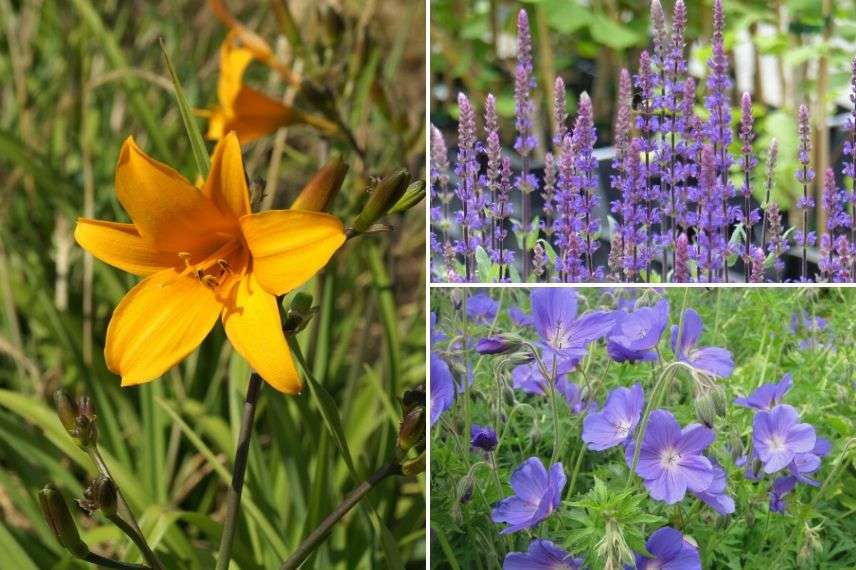
An example of an orange-and-violet combination: a few clumps of Daylily ‘Thumbelina’ mixed with Salvia nemorosa ‘Caradonna’ and hardy geranium ‘Orion’
If you opt for more sophisticated varieties such as Apricot Beauty, I recommend interspersing plants that flower earlier in spring or later in autumn to provide some foliage and avoid a “too much” effect. This will also prolong interest in your border over a longer period. Think grasses!
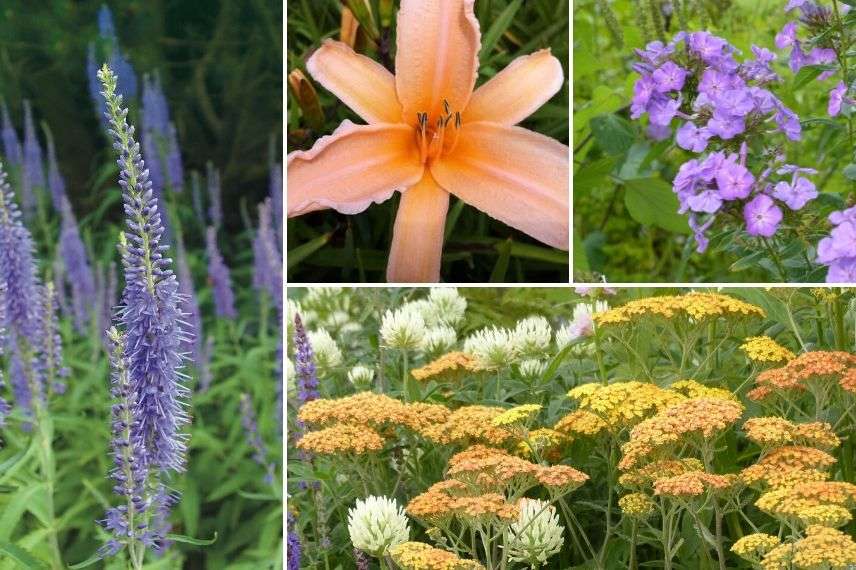
Another idea for a softer combination: Veronica longifolia, Daylily ‘George Cunningham’, Phlox paniculata ‘Blue Paradise’ and Achillea ‘Terracotta’
Finally, if you really want to expand the palette of orange flowers, consider dahlias, clivias, poppies, ranunculus, heleniums, crocosmias, certain echinaceas (coneflowers), some achilleas, orange geums or the classic marigolds and nasturtiums.
Find Pierre’s article on our blog: “I dared to pair orange and violet!
Discover other Hemerocallis - Daylilies
View all →Available in 3 sizes
Available in 1 sizes
Available in 3 sizes
Available in 1 sizes
Available in 2 sizes
Available in 2 sizes
Available in 3 sizes
Available in 2 sizes
Available in 1 sizes
Available in 2 sizes
In a naturalistic garden
To create a beautiful naturalistic association, favour varieties with single, not overly large flowers, in soft or plain colours such as the varieties :
- ‘Corky’ with golden-yellow flowers accented by brown sepals;
- Thumbelina with bright orange trumpets;
- H. middendorffii, a botanical species with star-shaped orange-yellow flowers;
- Mini Stella, a miniature with intense yellow flowers.
They pair with other airy, light perennials such as gauras and salvias… very fashionable plants! They are complemented by wild flowers such as scabious, sanguisorba, echinacea, astrance or mullein. And of course, the natural picture is completed by the presence of grasses with a flexible habit: canes, stipas or calamagrostis.
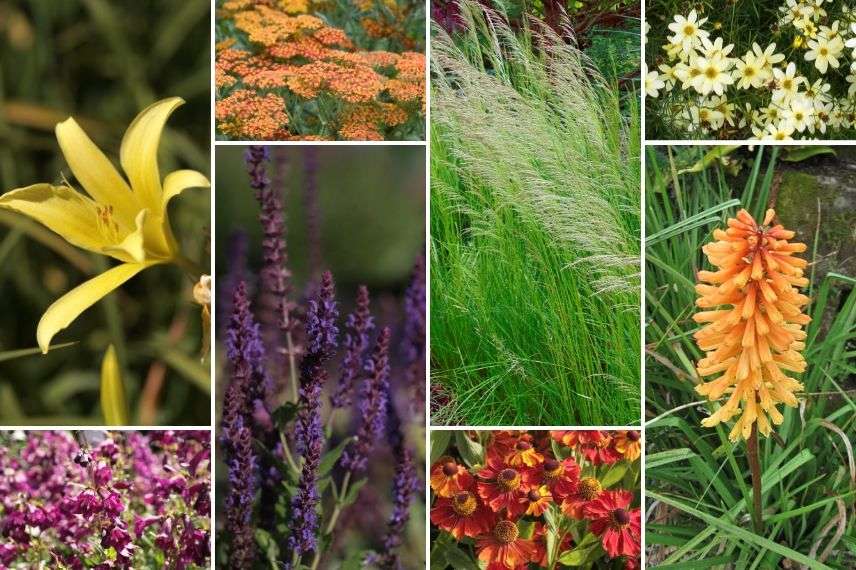
A fine example of a naturalistic pairing: Daylily ‘Corky’, Penstemon ‘Raven’, Yarrow ‘Walter Funcke’, Salvia nemorosa ‘Lubecca’, Deschampsia cespitosa ‘Goldschleier’, Helenium ‘Baudirektor Linne’, Coreopsis verticillata ‘Moonbeam’ and Kniphofia ‘Tawny King’
Daylilies in an exotic setting
Hemerocallis are flowers with very rich colours, from pure orange to purple and golden yellow. Some flowers can reach over 25 cm in diameter! These characteristics make them ideal for creating an exotic scene in your garden. Just pair them with other plants typical of this ambience such as :
- warm, vivid tones of Kniphofia and Crocosmia;
- colourful flowers and foliage of Canna, New Zealand flax or banana plant are must-haves;
- large, exotic, very colourful flowers of Birds of Paradise;
- scented flowers of Abyssinian gladiolus or star jasmine.
Finally, for an exotic setting, I recommend large-flowered varieties of Hemerocallis such as Ruby Spider with its incredible 22 cm flowers or Amadeus with its 15 cm flowers. Exotic ambience guaranteed!
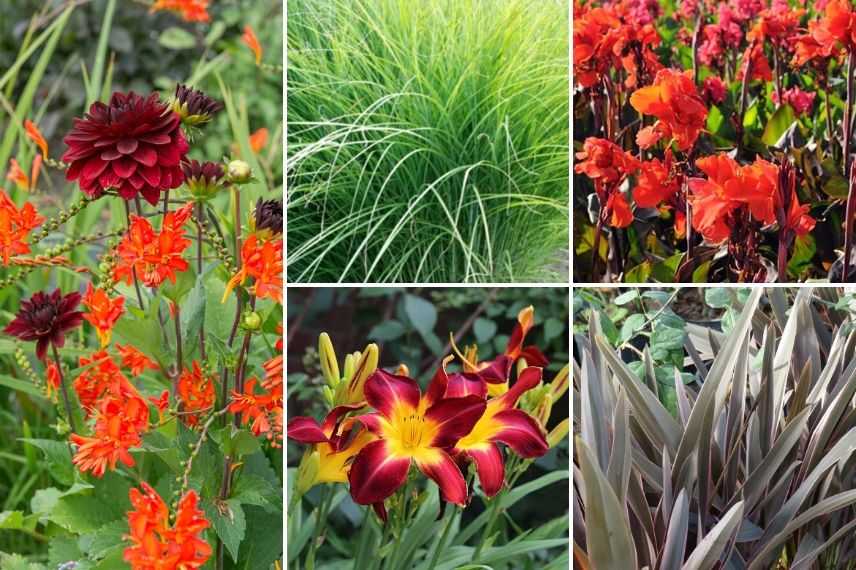
An example of an exotic combination: Crocosmia ‘Lucifer’ and Dahlia ‘Karma Choc’, Miscanthus ‘Gracillimus’, Canna ‘Red King Humbert’, Hemerocallis ‘Ruby Spider’ and Phormium ‘Pink Stripe’
In a romantic mixed border
In a romantic garden, you can choose daylilies with more sophisticated, double-flowered forms, preferably in soft colours, in shades of white, pink, yellow or purple such as the magnificent pink varieties like Neyron, Indian Giver or Everydaylily Rose, bicoloured flowers like Piano Man or Snowy Eyes or the very beautiful Double Dream.
To accompany these daylilies, think of timeless roses, peonies, dahlias and clematis. Pair them with columbines, foxgloves, astrances, sages, delphiniums, etc. I recommend varying flower shapes (large flowers beside small flowers so they set each other off). Play with tonal ranges too: gradients of pinks, mauve, with touches of purple and white.
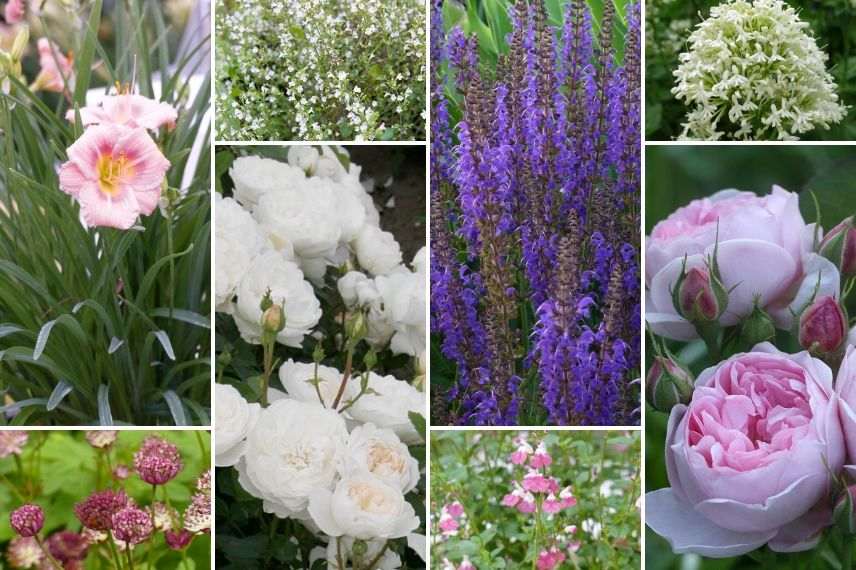
An example of a romantic combination : Daylily ‘Everydaylily Rose’, Astrance ‘Star of Teasure’, Calamintha sylvatica ‘Menthe’, rose ‘Glamis Castle’, Salvia nemorosa ‘Mainacht’, Salvia microphylla ‘Pink Lips’, Centranthus ruber ‘Albus’ and rose ‘Scepter’d Isle’
At the edge of a pond
Daylilies prefer cool, well-drained soil, especially in winter as they cannot tolerate standing water. Thus, they can be planted near a pond, taking care to encourage water infiltration with gravel or coarse sand. Combine them with essential waterside plants such as Siberian irises, loosestrifes, astilbes, Ligularia, thistles, Japanese primroses, etc. Some grasses can also complete the scene: Hakonechloa and Carex, to name but two. Not forgetting ferns if your pond is in partial shade.
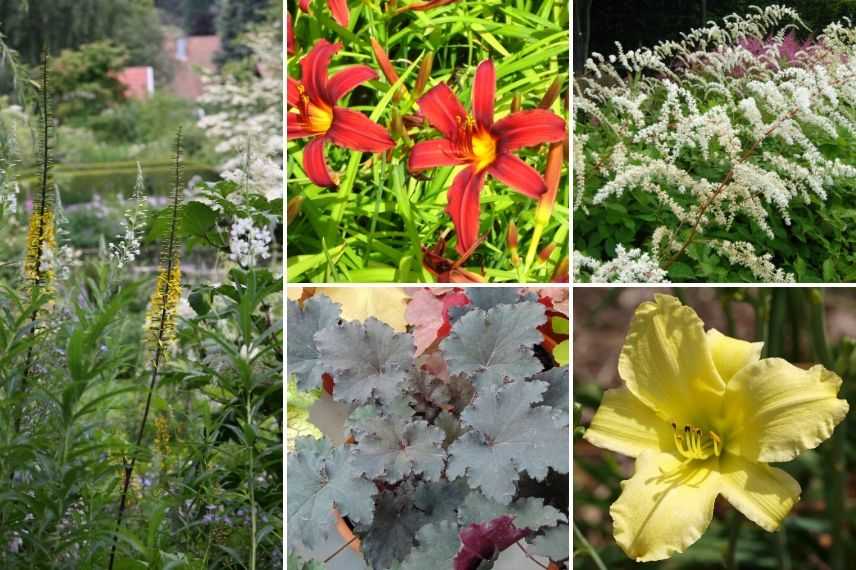
An example of a waterside combination at the water’s edge: Ligularia przewalskii, Hemerocallis ‘Crimson Pirate’, Astilbe thunbergii ‘Prof. van der Wielen’, Heuchera ‘Binoche’ and Hemerocallis ‘Alice in Wonderland’
Discover our full range of waterside perennial plants.
To dress a pond with submerged or floating plants, read our full article: 10 aquatic plants.
Warm gradient of yellows, oranges and reds
Have fun composing a scene in warm colours by mixing yellow, orange and red flowers.
Opt for the rich hues of Asteraceae such as Helianthus, Helenium, yellow Rudbeckias or Echinacea ‘Twisty’. Also consider more natural, upright yellow flowers such as Lysimachia, Solidago, Tanacetum ‘Isla Gold’ or classic gladioli. Heliopsis ‘Burning Heart’, Coreopsis verticillata ‘Route 66’ or Helenium ‘Dunkle Pracht’ with flowers shaded from red to yellow would also be perfect. Add a touch of orange with Crocosmia, Canna, nasturtiums or Californian or Iceland poppies. Don’t forget the red flowers of Helenium, purple Echinacea, Geum ‘Mrs Bradshaw’ or Phlox paniculata ‘Red Flame’. And don’t forget Dahlias! Obviously, all yellow daylilies and red daylilies are perfectly suited.
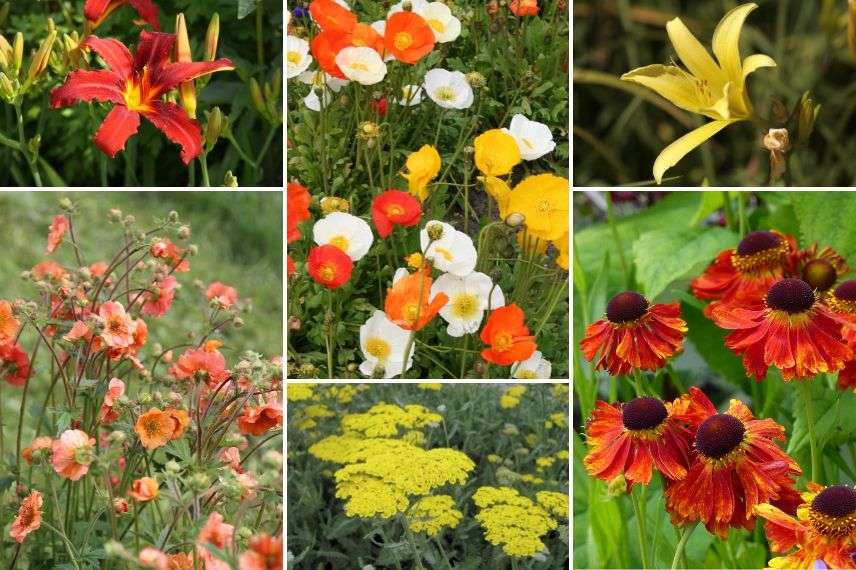
An example of a combination in a gradient of warm colours: Daylily ‘Sammy Russell’, Geum ‘Totally Tangerine’, Papaver nudicaule mix, Achillea ‘Moonshine’, Daylily ‘Corky’ and Helenium ‘Moerheim Beauty’
Also play with golden or purple foliage of Heuchera provided exposure is partial shade.
Finally, to learn everything about daylilies, consult our family sheet: “Daylily, planting, cultivation, division and maintenance“.
- Subscribe!
- Contents
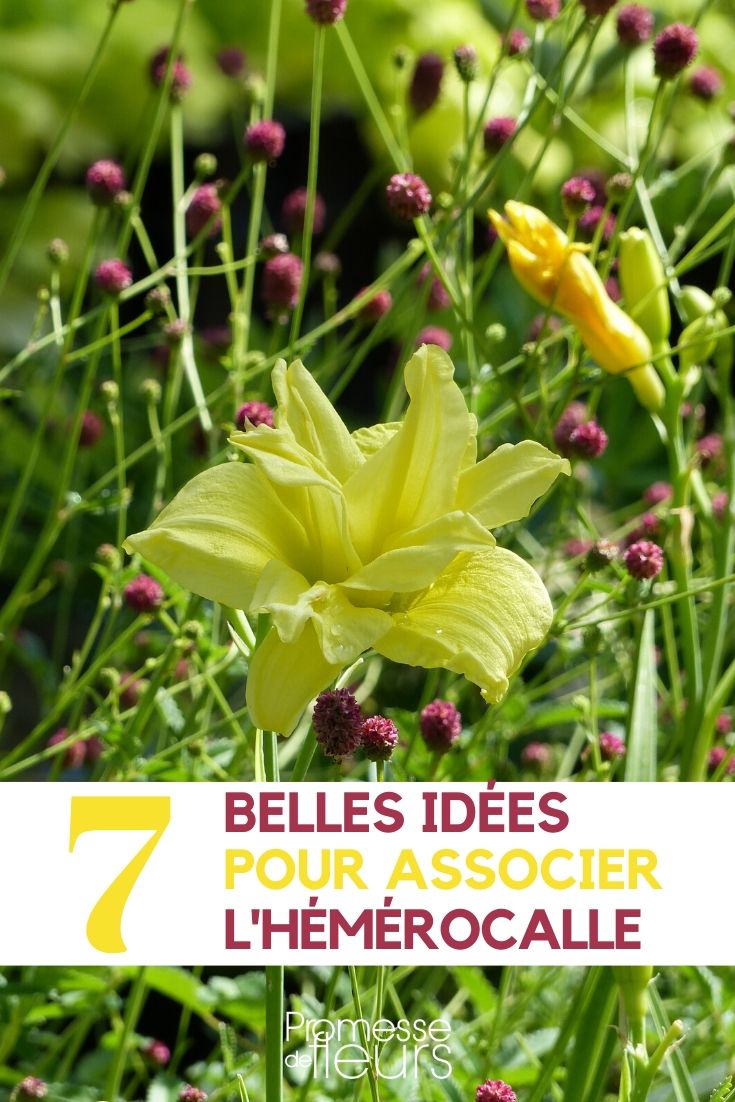































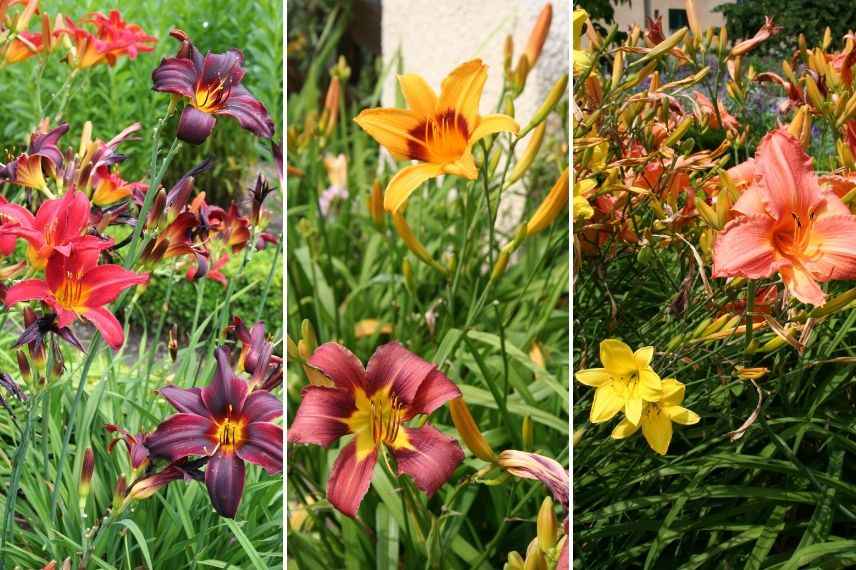
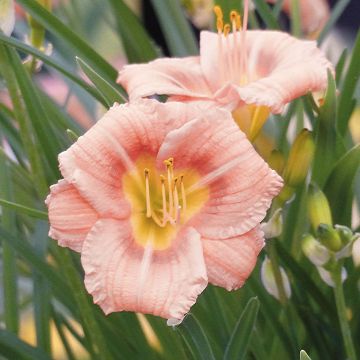
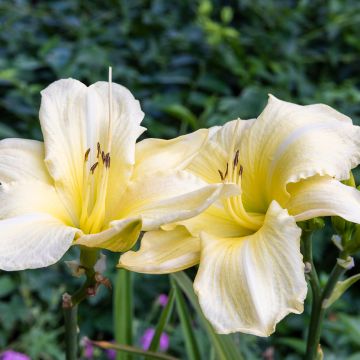
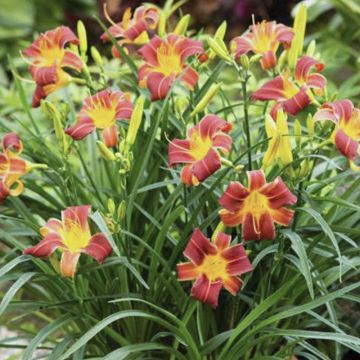
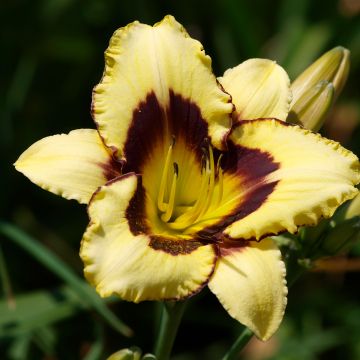
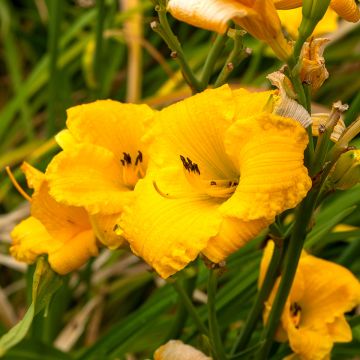

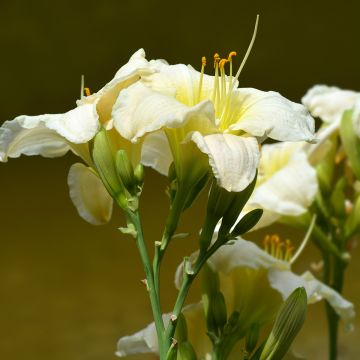
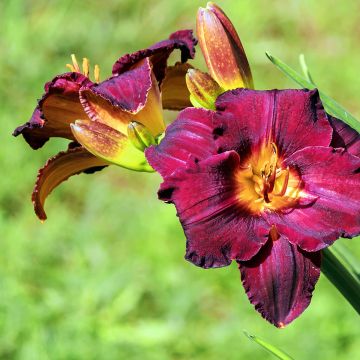
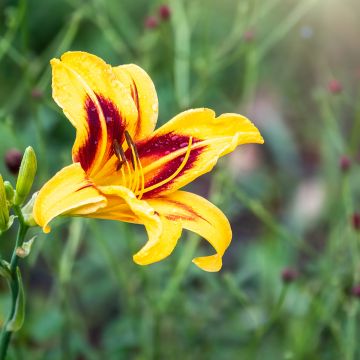
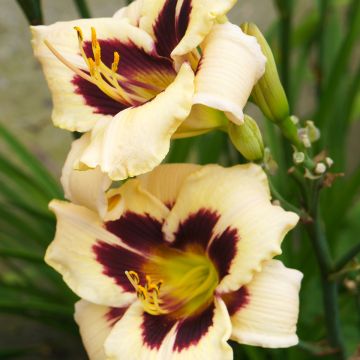
Comments